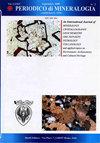意大利撒丁岛Su Seinargiu钼矿物显微拉曼光谱研究
IF 1.2
4区 地球科学
Q3 GEOCHEMISTRY & GEOPHYSICS
引用次数: 0
摘要
本文报道了意大利撒丁岛Su Seinargiu Mo-Bi远景区以铋钼氧化物(榴辉石、胶辉石和幔辉石)和钼酸盐(钽辉石-(Ce)、ichnusaite、nuragheite和suseinargiuite)为代表的钼矿物的拉曼光谱。利用先前通过x射线衍射和电子探针分析表征的样品收集拉曼光谱。铋钼氧化物的主要特征是在300 ~ 1000 cm -1范围内的条带,这与Mo-O键和Bi-O键的拉伸模式有关。在3000 ~ 4000 cm -1范围内观察到与O-H拉伸模式相关的宽频带。钼酸盐的拉曼光谱以出现在250 ~ 1000 cm -1之间的moo4基团的四种基本模式为特征。此外,还观察到与O-H键相关的弯曲和拉伸带。微拉曼光谱通常是鉴别这些稀有相的有效工具,本文讨论了一些例外情况。本文章由计算机程序翻译,如有差异,请以英文原文为准。
Micro-Raman spectroscopy of selected Mo minerals from Su Seinargiu (Sardinia, Italy)
Raman spectra of selected molybdenum minerals, represented both by bismuth-molybdenum oxides (sardignaite, gelosaite, and mambertiite) and by molybdates [tancaite-(Ce), ichnusaite, nuragheite, and suseinargiuite] from the Su Seinargiu Mo-Bi prospect (Sardinia, Italy) are reported. Raman spectra were collected using samples previously characterized through X-ray diffraction and electron-microprobe analyses. Bismuth-molybdenum oxides are mainly characterized by bands in the range between 300 and 1000 cm -1 , related to stretching modes of Mo–O and to Bi–O bonds. Broad bands related to O–H stretching modes were observed in the range between 3000 and 4000 cm -1 . Raman spectra of molybdates are characterized by the four fundamental modes of MoO 4 groups occurring between 250 and 1000 cm -1 . Additionally, bending and stretching bands related to O–H bonds were observed. Micro-Raman spectroscopy may usually be an efficient tool for the discrimination of these rare phases, with some exceptions discussed in the text.
求助全文
通过发布文献求助,成功后即可免费获取论文全文。
去求助
来源期刊

Periodico Di Mineralogia
地学-地球化学与地球物理
CiteScore
1.50
自引率
14.30%
发文量
0
审稿时长
>12 weeks
期刊介绍:
Periodico di Mineralogia is an international peer-reviewed Open Access journal publishing Research Articles, Letters and Reviews in Mineralogy, Crystallography, Geochemistry, Ore Deposits, Petrology, Volcanology and applied topics on Environment, Archaeometry and Cultural Heritage. The journal aims at encouraging scientists to publish their experimental and theoretical results in as much detail as possible. Accordingly, there is no restriction on article length. Additional data may be hosted on the web sites as Supplementary Information. The journal does not have article submission and processing charges. Colour is free of charges both on line and printed and no Open Access fees are requested. Short publication time is assured.
Periodico di Mineralogia is property of Sapienza Università di Roma and is published, both online and printed, three times a year.
 求助内容:
求助内容: 应助结果提醒方式:
应助结果提醒方式:


